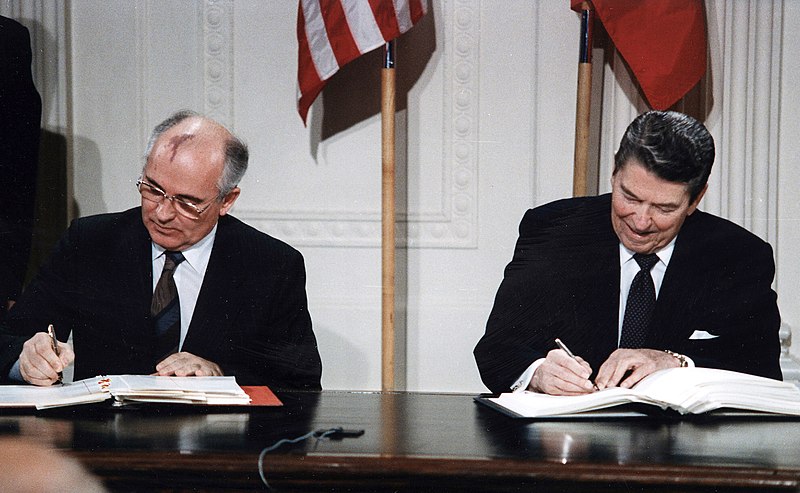Why isn’t anyone challenging the withdrawal?
US Presidents cannot just go around creating their own ‘emergencies’ to get what they want. President Trump’s attempt to use emergency funding to build his wall will certainly be challenged in the US courts. But what about his withdrawal two weeks ago from one of the most important treaties ever signed and ratified into law by the United States? The INF Treaty is quite explicit about the conditions required for withdrawal – this also requires an ‘emergency’ and none has been provided. Why are no US – or foreign – politicians, diplomats, academics, lawyers or journalists talking about this? NATO members should be refusing to accept this as a withdrawal, and so should the US Congress…
Conditions for withdrawal from the INF Treaty
On February 1st, Secretary of State Mike Pompeo announced that the US would withdraw from the INF Treaty in 6 months, in accordance with Article 15 of the treaty. But what does Article 15 of the treaty actually say about withdrawal?
Article 15, paragraph 1, says that the INF Treaty is of “unlimited duration.” Paragraph 2 then goes on to say:
“Each Party shall, in exercising its national sovereignty, have the right to withdraw from the Treaty if it decides that extraordinary events related to the subject matter of this Treaty have jeopardized its supreme interests. It shall give notice of its decision to withdraw to the other Party six months prior to withdrawal from this Treaty. Such notice shall include a statement of the extraordinary events the notifying Party regards as having jeopardized its supreme interests.”
What this means is quite clear: a party to this treaty cannot withdraw from it merely on the grounds that the other side is suspected of cheating, or has allegedly committed a ‘material breach’ of the treaty. There must be ‘extraordinary events’ that have ‘jeopardized the supreme interests’ of a party in order for that party to withdraw from a treaty as important as this one.
That clause was not put in there by accident. It was designed to make it very difficult for either side to pull out of this treaty simply because they didn’t like it or felt the other side wasn’t fulfilling their side of the bargain. The INF Treaty is all about defining the weapons systems that are to be prohibited under the treaty and the means by which each party can verify that the other party has eliminated these systems.
The INF Treaty was the first in history to have such a comprehensive and intrusive inspection and monitoring system for verifying the compliance of each side to the terms of the treaty. In addition to the treaty itself, the two sides concluded a whole swath of supplementary memoranda and protocols to clarify which containers on a military base the inspectors from the other side may be permitted to open, what parking facilities must be made available to them, and even what size measuring tape they are allowed to bring with them.
They expected the INF treaty to be enforced by the most advanced methods of verification available. And therefore the idea that one side might decide to cheat, or the other side to pull out because they suspected cheating, was ruled out as a reason for allowing either side to withdraw from their treaty obligations.
The INF Treaty was specifically written to ensure that the only way either side could withdraw from this treaty was if some new unforeseen set of circumstances arose that fundamentally changed the relationship of the parties and rendered the treaty no longer in their ‘supreme interests.’ Nothing short of this is permitted by the terms of this treaty.
US withdrawal from the ABM Treaty
The language of Article 15 is, in fact, the exact same language used in the ABM Treaty of 1972. That treaty was also meant to be of unlimited duration, unless ‘extraordinary events’ jeopardized the ‘supreme interests’ of one of the parties.
The US unilaterally withdrew from the ABM Treaty in 2002, after giving 6 months notice as required by the treaty. In justifying the US withdrawal from the ABM Treaty at that time, President George W. Bush referred very specifically to the ‘extraordinary events’ that had occurred just 3 months prior to his announcement. He was referring, of course, to 9/11.
“Today, as the events of September the 11th made all too clear, the greatest threats to both our countries come not from each other, or other big powers in the world, but from terrorists who strike without warning, or rogue states who seek weapons of mass destruction… We know that the terrorists, and some of those who support them, seek the ability to deliver death and destruction to our doorstep via missile. And we must have the freedom and the flexibility to develop effective defenses against those attacks…”
Whether or not 9/11 was the real reason for wanting to abandon the ABM Treaty, the fact is that to do so required an ‘extraordinary event,’ and George W. Bush just happened to have one available. He was also able to use that extraordinary event to explain why the supreme interests of the United States had changed, from needing to defend itself against missile threats emanating from the Soviet Union to needing to defend itself from missile threats potentially emanating from other hostile states or ‘terrorists.’
Does deployment of a new Russian missile qualify as an ‘extraordinary event’?
Like the United States, Russia has been developing and deploying shorter-range missile systems (with a range of 500 km or less) as well as longer-range missiles (with a range of 5,550 km or more) since long before the INF Treaty outlawed the missiles with ranges in between these two limits (with ranges between 500-5,500 km).
The Russian 9M729 missile is the one that the US alleges to be a violation of the INF Treaty and its sole justification for withdrawal. This particular missile is an upgrade of the 9M728 missile, which is itself an upgrade from other missiles stretching right back to the 1980s. Throughout this entire period, many of these missiles have had ranges of ‘up to’ 500 km, in other words, right up to the line defined as allowable under the INF Treaty. The 9M728, for instance, has been deployed by Russia since 2009 and has a reputed range of 500 km. The US has never raised an objection to any of these other missiles as being in violation of the INF Treaty limitations, despite their ranges being very close to maximum allowed under the treaty.
Has Russia violated the INF Treaty?
Russia began testing the 9M729 in 2014 and starting deploying this missile in 2017. According to the Russians, it is 530 mm (1½ feet) longer than the previous 9M728 missile. They claim that the extra length is to fit in a more complex guidance system, and that its range is actually slightly less than range of the 9M728 – in other words, still just within the range allowed by the INF Treaty. US intelligence sources claim that the extra length means this missile is capable of a much greater range than the Russians claim, which would put it beyond the range allowed by the INF Treaty. The evidence for this claim has not been made public.
Interestingly, at least according to some reports, the US has notsaid that they have seen this particular missile actually fly further than 500 km. It is very difficult for the US or the Russians to test a missile without the other side monitoring the results very closely. If the Russians had flown this missile further than 500 km in a test flight, that would have been known and easily made public. But that is not what the US is claiming.
What the US is claiming about this particular missile is that they have seen an ‘equivalent’ missile tested to a much greater distance (for other purposes that are allowable by the INF Treaty). The US says this other missile test confirms the ‘real’ range of the 9M729, and makes it a system not allowed by the INF Treaty. The US claims Russia did all the testing for this missile in an underhanded way in order to prevent the US from detecting the ‘true’ range of the 9M729 missile. This is an extremely convoluted claim, which may be true, but has yet to be proven. The only way to prove the actual range of this missile would be through a technical inspection by military experts, followed by a closely observed test firing of the missile.
The INF Treaty provides the mechanisms for verifying whether this particular missile is outside the acceptable range or not. If were clearly demonstrated that this missile is in violation of the treaty, the next question is whether it constitutes an ‘extraordinary event’ sufficient to justify withdrawal from the treaty. But in addition to that is the question of whether deployment of this missile ‘jeopardizes the supreme interests’ of the United States.
Even assuming the greater range that the US claims this missile has, it still would not reach the United States from where it is being deployed. As one defense analyst has put it, this missile is “a minor accessory to the nuclear wardrobe of the Russian Federation.” In other words, this missile is militarily insignificant. And it is a minor development on top of other developments which have not caused the US to complain up to now, so it would be extremely difficult to argue that the deployment of the 9M729 is sufficient grounds for withdrawal from the treaty.
What does ‘suspension’ of the treaty mean?
Simultaneous with his announcement that the US was giving notice that it would ‘withdraw’ from the INF Treaty in 6 months, Secretary of State Mike Pompeo also announced that the US was ‘suspending’ its obligations under the treaty with immediate effect.
The INF Treaty itself makes no mention of allowing either party to ‘suspend’ its obligations under the treaty. Therefore, the Vienna Convention on the Law of Treaties kicks in with its generic rules about treaty suspension. A suspension is generally allowed in order to resolve a dispute about the treaty itself. This might mean, for instance, taking a case to the International Court of Justice or another outside body to determine if one side or the other is in material breach of the treaty.
However, an important condition is laid upon the parties to a treaty suspension by the Vienna Convention. “During the period of the suspension the parties shall refrain from acts tending to obstruct the resumption of the operation of the treaty.” In other words, when it comes to suspension of the INF Treaty, neither side should develop or deploy missiles that would make it impossible to resume operation of the treaty were the suspension to be lifted.
Even if it were proven that Russia is violating the INF Treaty, which so far is only an unproven allegation, that alone would be insufficient legal grounds for withdrawing from the treaty. The Trump administration would need to demonstrate that some extraordinary event relating to the deployment of intermediate range missiles has now jeopardized the supreme interests of the United States to such an extent that it must withdraw from this particular treaty.
In the meantime, serious politicians, diplomats, academics and journalists from all sides of this issue should be demanding that the current ‘suspension’ of the treaty be used to investigate and clarify whether either side is currently violating the treaty, and to come up with a plan, within the terms of the INF Treaty itself, for how to deal with that. And, of course, neither side should deploy any further missiles that might contravene the treaty while it remains suspended.
Dr. Timmon Wallis is Executive Director of NuclearBan.US and author of Disarming the Nuclear Argument, Luath Press, 2018.








